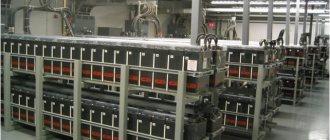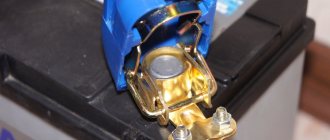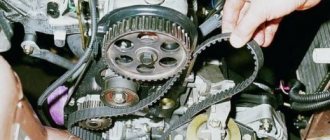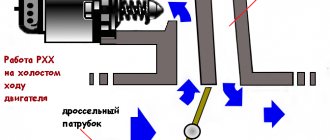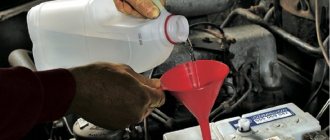When the need arises to replace an old battery in a car, the car owner has an impressive list of options for purchase. Indeed, the current range of batteries is striking in its diversity.
And among them, so-called hybrid batteries are quite common. It is a mistake to think that they are intended for similar cars, that is, cars with a hybrid power plant. The name is due to the production technology.
Such batteries are quite popular and in demand, they have their own strengths and weaknesses. Before purchasing, it is important to understand what they are and how to properly charge and maintain hybrid batteries.
What it is
First you need to understand what the concept of a hybrid battery means.
These are batteries whose production uses 2 technologies.
Hybrid batteries are those in which the positive plates are made using low-antimony technology, and the negative plates are made using calcium technology.
Due to this, the hybrid receives higher starting current and also becomes less susceptible to discharge.
A common mistake is to call hybrid batteries calcium. In fact, there is a separate concept of calcium batteries. This is a newer and more advanced technology that makes a completely calcium-based battery maintenance-free.
But hybrid batteries, which, although they encounter significantly lower volumes of water evaporation, still remain serviceable. They are usually called low-maintenance.
Hybrid batteries have screw-on caps, when opened, you can add distilled water inside the cans and check the density of the electrolyte and its level.
Flaws
Unfortunately, even the newest and most advanced design, which has a large number of innovative technologies, is not without drawbacks. In the case of hybrid batteries, there are only two of them. The first of them is the high price. Indeed, compared to conventional maintenance-free batteries, the price tag can be up to several times higher. However, this is more than justified by the long battery life and its high discharge resistance.
In addition, such batteries are not very common on the market. This means that such a battery can only be purchased in specialized stores, and the likelihood of running into counterfeit goods is quite high.
Features of the technology
It is worth studying in more detail the hybrid technology of such batteries, which have proven to be quite in demand and popular among motorists.
The current design of hybrids is such that 2 types of plates are used here:
- antimony technology, which involves treating lead plates with antimony, makes the battery more resistant to deep discharges;
- adding calcium to another part of the plates is necessary to reduce self-discharge and reduce water evaporation.
The combination of the two technologies has a positive effect on the service life of hybrid car batteries.
One of the advantages of hybrid technology is precisely the increased service life when compared with conventional batteries based entirely on antimony technology.
Typically, the manufacturer may indicate that the warranty period is 5-7 years. But in order to achieve such indicators, it will be necessary to maintain the battery in a constant stable and working condition. And this presupposes timely and correct maintenance, charging, adding water, etc.
DIY ways to restore charge
How to charge a battery with a small asymmetric charging current in accordance with the diagram? In practice, there are two methods to accomplish this task - either use a constant current or a constant voltage value. In this case, there are no special differences in these methods - each of the methods is considered complete and effective. Naturally, if all the necessary points and nuances are observed during their implementation.
Method 1 - constant current
First, we suggest that you familiarize yourself with the first method of restoring battery functionality by using constant current. A distinctive feature of this method is that the vehicle owner needs to periodically monitor the parameter value on the charging device. And if the need arises, the current will need to be adjusted. Typically, the diagnostic and testing process is carried out once every 1-2 hours, but it is advisable not less often (the author of the video is the Nizhny Novgorod Battery Man channel).
What current is best to use to implement this method? The process itself is carried out taking into account a constant value - the value should be about 0.1% of the total capacity of the car battery. At this current, the battery will be discharged within 20 hours. That is, if there is 75 Ah, then the current value to restore the battery charge should be about 7.5 amperes. How to limit this value - most modern chargers have a special regulator; you can limit the value of the parameter using it.
It is also necessary to say separately about maintenance-free batteries. When restoring the functionality of such a device, it is necessary to increase the voltage value when charging to 15 volts, while simultaneously reducing the current value by 50%. That is, if the capacity of the device used is 60 Ah, then the current value should be set at 3 amperes. You can tell that it is fully charged by the fact that during 1-2 hours of charging, all operating values remain unchanged. If the device itself is not serviceable, then the recovery procedure can be completed when the voltage on the device is 16.4 volts.
The second method is at constant voltage
Another method is at a constant voltage, no more difficult to implement and no less effective.
The charging procedure must be carried out for at least 24 hours:
- The device is removed from the car; to do this, all terminals are disconnected and the clamps are disconnected.
- The battery is removed and the charger probes are connected to its terminals.
- Then, you will need to wait, as mentioned above, about a day. After this, you should check the parameters on the charger display (the author of the video is the Battery Manager channel).
How to understand that the battery is charged:
- if the voltage parameter is 14.4 volts, then approximately 75-85% of the battery charge can be restored over the next 24 hours, but in this case much depends on the characteristics of the battery;
- if the voltage parameter varies around 15 volts, this indicates that the battery is approximately 85-90% full;
- when the voltage parameter is about 16 V, then we can conclude that the battery is approximately 95-97% charged, that is, its further operation, in principle, is already allowed;
- If you want the device to recharge to the maximum, then it will take no more than a day to complete this task; a voltage of 16.3 V can indicate the charge.
If you are the owner of a more modern charging device, then on its body there may be special indicators - light bulbs - with which you can determine the completion of the process. When the battery is ready for use, the indicator will turn green. If its color is red, then the procedure is either not completed, or problems arose during the execution process; more detailed diagnostics are required. Many battery experts argue that maintenance-free batteries need to be recharged to approximately 95%; this option is considered the most relevant. In this case, the battery will be able to fully work out its entire service life, but it is necessary to ensure that the voltage parameter is at least 14.4 volts.
Photo gallery “Battery malfunctions”
Marking
A little more about how hybrid power supplies can be designated.
Each manufacturer chooses its own designations and labeling, which is rather a marketing ploy.
But most often the following inscriptions are found on the battery case:
- Hybrid;
- Ca+;
- Calcium Plus.
The “Ca/Ca” label already indicates that this is an all-calcium battery.
Also, the labeling of hybrids usually contains additional symbols. They indicate how intensively the water in the battery will be consumed.
The following options are possible here, indicated as the last letter of the marking:
- That is Normal. This letter indicates that water consumption will be normal. These are usually the most inexpensive hybrid batteries;
- Stands for Low. That is, the consumption is low;
- Or Very Low. Here the water consumption will be the smallest.
You can also find markings in the form of VRLA. This indicates the presence of a control valve in the battery.
Based on these designations, you can roughly understand how often you will need to service the battery, that is, basically add distilled water to the jars.
Selecting the optimal current for charging the battery
What current should I use to charge a car battery? The answer is permanent. In order to maintain this condition, the presence of rectifiers is necessary. They are designed to change the voltage or current in the process of replenishing energy. Ensuring these conditions guarantees optimal recovery and longer service life of the power supply.
For a 12-volt battery, a voltage of 14.5 - 16.5 volts will be required. Slightly increased indicators will be needed for a better “flow” of energy into the unit. Since the voltage inside will be slightly less, a difference will appear, and the current will reach its target much easier. If both internal and external voltages are equal, the process will not take place.
The value of 14.5 volts is used in the process of charging conventional lead batteries. Voltage indicators that are higher than this figure are used to replenish the energy of maintenance-free batteries. The recovery time for such batteries is much shorter.
You can select the battery of the required capacity based on the engine displacement, like this: 55 Ah is suitable for a volume of 1 - 1.6 liters, 60 Ah is suitable for a volume of 1.3 - 1.6 liters, and a capacity of 75 Ah is suitable for 1.6 - 3 .2 liters. The most common capacities are: 55 and 60 ampere-hours, and the rarest is 190 ampere-hours.
Maintenance Recommendations
When compared with conventional WET batteries based on low-antimony technology, the cost of hybrid models is noticeably higher. But this still does not prevent hybrids from actively spreading and being among the most popular types of batteries.
The main reason for its popularity can be considered the ratio of price, quality and comparative ease of maintenance. If a motorist is used to working with fully serviced batteries that require constant monitoring of condition and topping up water, the transition to a hybrid battery will pleasantly surprise him. After all, such a battery will have to devote significantly less time and effort.
The most important problem can be considered the boiling away of water from the electrolyte, which does not occur so actively, but still this phenomenon could not be completely eliminated in the hybrid technology. Therefore, topping up the liquid will be required.
Several recommendations can be given in this regard:
- periodically check the level and condition of the working fluid in the battery;
- many hybrids have special marks on the transparent part of the body;
- Some hybrid batteries use a color eye indicator, which is relevant for completely maintenance-free batteries;
- if the electrolyte level drops due to water evaporation, the liquid component should be added;
- Only distilled water is allowed to be added;
- it is impossible to increase the level by adding ready-made electrolyte;
- if it is necessary to increase the density of the electrolyte, this is achieved by charging.
During the charging process, part of the liquid evaporates, and thereby the ratio of water and sulfuric acid in the electrolyte composition changes.
Hybrid Battery Maintenance
Despite the relatively high cost, hybrid batteries are becoming increasingly popular. This is due to the fact that maintenance of these batteries is quite simple.
Hybrid power supplies require special attention in hot summers - at this time, water boils away from the electrolyte at its maximum. To avoid damaging the battery, you should periodically check the amount of solution and its density. Most batteries have marks at which the electrolyte should be located. Some batteries are equipped with an indicator. If the acid level drops, add distilled water. The hybrid must be cleaned if a white coating appears on the plates - lead sulfate.
Hybrid Battery Desulphation
The process of lead sulfates appearing on the plates is natural for all batteries - after all, the electrolyte enters into a chemical reaction with lead elements. However, incorrect acidity of the composition can accelerate the destruction of the plates. Therefore, it is recommended to carry out desulfation - cleaning from lead sulfates.
How to correctly perform this procedure? Restoring battery plates is carried out in several ways:
- cycle of short and weak charges and discharges;
- using a chemical solution poured into jars;
- Disassemble the battery and clean it manually.
Important! The last method is described on the Internet, but without the necessary skills it can lead to complete damage to the battery!
Desulfation requires the use of a special charger. It alternates voltage supply and discharge. During operation, the charger display will display information about the amount of capacity restored.
If you do not have special equipment, you can use a regular charger, but with the ability to set amperes and volts. How to charge and discharge correctly?
- Check the electrolyte level. If the readings are low, add distilled water.
- Set the voltage on the equipment to ~14.2 volts and the current to 1 ampere.
- Connect the charger terminals to the battery.
- Leave it overnight. The battery voltage should increase to 10 volts.
- Leave it for a day without charging.
- Next, we increase the current to 2-2.5 amperes and charge for another 8 hours. We observe an increase in density to 1.12 g/cm3 and voltage to 12.8 volts.
- A tangible shock, such as a high-beam lamp, is required to initiate desulfuration. Leave for 6-8 hours, the voltage reading should drop to 9 volts.
- We repeat the cycle - charge with a low current, leave overnight without charging, charge with an increased current, discharge.
Desulfation should be considered successfully completed after the electrolyte density reaches 1.27 g/cm3. The entire process may take up to two weeks, but it will help restore the functionality of the hybrid battery.
Sulfation problem
Since this is a lead-acid battery with a liquid electrolyte, the problem of sulfation for hybrid batteries is more than relevant.
Sulfation occurs when the voltage drops and the density of the electrolyte decreases. It manifests itself in the form of a white coating that settles on the surfaces of lead plates. This is lead sulfate.
Therefore, in order to minimize possible sulfation, it is recommended to try to maintain the battery in working condition, monitor the voltage at the terminals, and also check the electrolyte levels in a timely manner.
But if it was not possible to avoid sulfation, the battery manufactured using hybrid technology is desulfated.
There are several basic desulfation methods suitable for hybrids:
- Pulse cleaning. To do this, you will need a special device called a desulfator. It delivers short current pulses, thereby provoking the gradual destruction and dissolution of lead sulfate in the electrolyte. But the device is expensive, and not everyone decides to buy it for personal purposes.
- Charger with desulfation function. Recently, new chargers have become popular, which have the function of destroying lead sulfate. The cost of such memory devices is higher compared to conventional devices. But the efficiency of their work is quite high.
- Auto chemical goods. Usually it is poured into battery banks, then the battery is connected to the charger. Chemistry reacts with sulfate and destroys it. Then washing is carried out, fresh electrolyte is poured in and normal charging is performed.
- Distilled water. Suitable for cases where sulfation has not significantly affected the plates. You need to drain the electrolyte, pour distilled water into the jars and start the charging process. The water should bubble a little, but not boil away. The water will need to be replaced several times. The downside is that recovery takes quite a long time.
- Mechanical cleaning. Not the most acceptable method, which is best used in extreme cases. The idea is to cut out a piece of plastic on the body, remove the plates, wash them, clean them and put them back in place. Here the integrity of the body is compromised, and it is not so easy to restore it.
- Polarity reversal. It is rightly considered the most last resort when all else fails. The point is simple. You need to connect the battery to the charger, but only connect the plus to the minus, and the minus to the plus. Here either the battery will be restored or completely fail.
If you have financial capabilities, if the hybrid battery has been in service for many years and does not perform its tasks well, the most correct decision would be to purchase a new power source. The same hybrid, or any other, will be decided by the car owner himself.
General principles of battery charging
What charging current should be used for a 60A car battery? Before you begin the charging procedure, you need to familiarize yourself with the technical characteristics of the battery used. You also need to study the characteristics of the charger. Regardless of the characteristics of the battery used, it is desirable that the charge current or voltage be constant. If you do not know how to limit the signal yourself, you can add a rectifier element to the electrical connection circuit, which is used to adjust the voltage value.
When purchasing or renting a charger, you should also carefully study all the technical features and characteristics of the device. This is important because the memory may have certain capabilities. For example, if the charger will be used to work with a 12-volt battery, then most devices can increase the voltage to 16 volts if necessary. This is usually done to restore the functionality of unmaintained batteries.
Charging rules
It is also worth considering the charging features for hybrid batteries. There is nothing complicated here.
Unlike calcium batteries, hybrids do not require cyclic charging
Therefore, even a beginner without much experience can figure out how to properly charge hybrid batteries.
Here it is necessary to take into account the charging current, as well as to what voltage the starter hybrid car battery will need to be charged.
Actually there are 2 ways:
- Fast charging. The easiest way to charge a hybrid battery from your car is with an automatic charger, choosing a charge current rated at 10% of the battery capacity. But for the technology under consideration, this method is not recommended to be used on an ongoing basis. It is best used when the driver has limited time and the capacity needs to be restored quickly.
- Correct charging. For hybrids, a more correct solution would be to charge using a current of 2 Amps with a voltage of 14.2 V.
If you choose the second charging option, this will significantly extend the service life and maintain performance characteristics. But recharging with voltage takes much longer.
A sign that charging is complete is that the voltage is 14.2 V and the current has dropped to 0.5 A.
High current is considered detrimental to hybrid batteries. Therefore, you should not apply too high values to them when charging. Otherwise, you can literally condemn the battery with your own hands and send it for recycling.
Charging car batteries
Let's start from the situation when the device is inactive (turned off). What voltage or current should I use to charge a car battery when the device is in storage?
Under battery storage conditions, the main purpose of charging is to compensate for self-discharge. In this case, charging is usually performed with low currents.
The range of charge values is usually from 25 to 100 mA. In this case, the charge voltage must be maintained within the range of 2.18 - 2.25 volts in relation to a single battery bank.
Selecting battery charging conditions
The battery charging current is usually adjusted to a certain value depending on the specified charging time.
Preparing a car battery for recharging in a mode that needs to be determined taking into account the technological properties and technical parameters during operation of the battery
So, if you plan to charge the battery for 20 hours, the optimal charge current parameter is considered to be 0.05 C (that is, 5% of the nominal capacity of the battery).
Accordingly, the values will increase proportionally if one of the parameters is changed. For example, with a 10-hour charge, the current will already be 0.1C.
Charging in a two-stage cycle
In this mode, initially (the first stage) a charge is carried out with a current of 1.5 C until the voltage on a separate bank reaches 2.4 volts.
After this, the charger is switched to a charge current mode of 0.1 C and continues to charge until the capacity is full for 2 - 2.5 hours (second stage).
The charge voltage in the second stage mode varies between 2.5 - 2.7 volts for one can.
Forced charge mode
The principle of forced charging involves setting the charging current value at 95% of the nominal battery capacity - 0.95C.
The method is quite aggressive, but it allows you to charge the battery almost completely in just 2.5-3 hours (in practice 90%). Charging up to 100% capacity in a forced mode will take 4 – 5 hours.
Control training cycle
The practice of operating automobile batteries shows a positive result when the control and training cycle is applied to new batteries that have not yet been used.
For this option, charging with parameters calculated by a simple formula is optimal:
I = 0.1 * C20;
Charge until the voltage on a single bank is 2.4 volts, after which the charging current is reduced to the value:
I = 0.05 * C20;
With these parameters, the process is continued until fully charged.
The control and training cycle also covers discharge practice, when the battery is discharged with a small current of 0.1 C to a total voltage level of 10.4 volts.
In this case, the degree of electrolyte density is maintained at 1.24 g/cm 3 . After discharge, the device is charged according to standard methods.
Where are calcium batteries used?
Calcium-type batteries are used as starting units in cars and trucks, and yes, this is not a myth. If the battery is maintenance-free, then it can be used as a storage device in powerful power supplies. When using a calcium battery in homemade inverter devices, you should definitely install a fuse that will help automatically turn off the battery if it is severely discharged.
Power distribution device
The torque and energy of the internal combustion engine and both motor/generators are combined and distributed by a planetary gear set, called a Power Split Device (PSD) by TOYOTA. And although it is quite simple to manufacture, it is not so easy to immediately understand how it works. Therefore, we will devote enough time to it.
Thus, the internal combustion engine can spin the wheels directly (mechanically) through the PSD. At the same time, a variable amount of power can be removed from the internal combustion engine, turning this rotational energy into electrical energy. It can charge the battery or be sent to one of the motors/generators to help turn the wheels. The flexibility of this mechanical/electrical power distributor allows the Prius to improve fuel economy and reduce emissions while driving.
Prius K10 standard monitor with the ignition on. In this case, the standard charger cannot be activated in any way. The monitor is installed in the center of the car’s front console
Normal characteristics of the charger and battery will ensure uninterrupted operation.
Nuances of choosing a battery
When purchasing a hybrid battery, you need to pay attention to:
- production date - the optimal period between the time of production and purchase is 2-3 months;
- dimensions - the battery must completely fit in its place;
- capacity sufficient to start the motor;
- terminal polarity;
- need for maintenance.
Memory selection criteria
When purchasing a charger, focus on:
- optimal voltage limit – from 13.8 to 14.2 V;
- maximum current requirements in accordance with the battery capacity;
- presence of power and current limiter;
- type of device - recharging models are distinguished by a gentle cycle, and start-charging ones are used for desulfation and restoration of factory capacity.
Advice!
An automatic charger with cycle blocking will prevent damage to the power source if the terminals are connected incorrectly.
Memory selection criteria
Advice!
An automatic charger with cycle blocking will prevent damage to the power source if the terminals are connected incorrectly.
Types of maintenance free batteries
Maintenance-free battery types include:
- Batteries made using SLA technology filled with acid diluted with distilled water in a certain ratio;
- Improved batteries with liquid electrolyte (manufacturing technology name - EFB);
- Made using AGM technology;
- With gel liquid electrolyte (abbreviated as GEL).
The charging algorithm for maintenance-free current sources depends on their type. Let's take a closer look.
- Initially, the first type of maintenance-free acid batteries, in terms of their technical characteristics, did not differ from their classic “brothers”. The difference was the absence of the usual filler plugs.
- The second type of battery is manufactured by EFB technology. Further improvement of acid batteries led to the use of envelope-shaped separators in their design. Lead plates are placed in them. In these batteries, which are an intermediate option between conventional lead batteries and those made using AGM technology, not acid is used as an electrolyte, but a special electrochemical type liquid.
- Power sources made using AGM technology do not use a liquid electrolyte, but an absorbed one, which fills the battery compartments filled with porous fiberglass mats.
- Gel batteries use a gel-like electrolyte with the addition of silicic acid. Otherwise, the design is no different from other types of maintenance-free batteries.
The charging algorithm for maintenance-free batteries is almost the same. However, the maximum charging current and voltage are different.
- SLA/EFB: Maximum current is 0.1 x battery capacity. Voltage 14.2…14.5.
- AGM: The maximum charging current is 0.2 x battery capacity. Voltage 14.6…14.8.
- GEL: The maximum current is 0.2 x battery capacity. Voltage 14.1…14.4.
Evolution
The accelerated development was largely prompted by decisions to tighten the requirements for the characteristics of car batteries. The changes affected the requirements for starting current, battery weight, water consumption, etc. Manufacturers were forced to solve these problems and, as a result, new technologies appeared. Since it was difficult to change anything in the fundamental design, battery creators began to improve the composition and design of the electrodes. Before moving directly to hybrid batteries, let's consider the way to improve them.
Antimony
The first batteries with alloying additives were antimony. As the name implies, antimony was added to the lead plates. Current collectors for such batteries are manufactured using casting technology at high temperatures. This type of battery is most susceptible to water boiling away from the electrolyte, self-discharge and sulfation.
Calcium
In these models, manufacturers used calcium as an alloying component of lead plates, and also improved the technology for their production. In this case, the electrode plates are made by cutting through a solid tape. After that, it is stretched and a cellular structure is formed. The tape is produced by casting at low temperature.
This is especially important for the lattice veins, which have become less fragile and susceptible to corrosion processes. It is also important that the electrodes have become cleaner in their chemical composition. This reduced the self-discharge of car batteries during storage. The technology is called ExMET (Expanded Metal).
Along with these improvements, the production of car batteries has also been modernized. In one technological cycle, a paste was prepared with electrodes. Pasting, drying, and formation of groups of down conductors were carried out. When applying the coating, a number of technological measures were taken to prevent their sticking. Production has been largely automated and its environmental aspects have been improved.
Advantages and disadvantages of calcium batteries
Calcium batteries have both advantages and disadvantages. The advantages of these units include:
- Long service life.
- Very low self-discharge level.
- The level of water electrolysis has been seriously reduced.
- Stable plates.
- Virtually no corrosion.
- Withstands a long recharge.
- Higher cold cranking current.
- They are often sold as completely maintenance-free.
The disadvantages of calcium batteries include:
- With frequent discharges to zero, the battery will eventually die completely.
- Due to the use of more complex technology, such batteries cost a lot of money.
- If the battery is not used for a long period of time or if the battery is constantly undercharged, its service life will decrease.
Despite the high price tag, with careful use, you can save a lot of money by increasing the service life of the product up to ten years. If a maintenance-free modification is purchased, then the temporary costs of servicing the battery are reduced to only periodic charging.
Hybrid batteries – simplicity and durability
The high-voltage battery of the Prius K10 consists of 240 cells with a nominal voltage of 1.2 V each. They are very similar to batteries for a D-size flashlight. These elements are assembled in groups of 6 into so-called “bamboos” (there is a slight similarity in appearance). The battery consists of two buildings containing 20 “bamboos”.
The total nominal voltage of the VVB is 288 V. Its operating voltage fluctuates in idle mode from 320 to 340 V. When the voltage in the battery drops to 288 V, starting the internal combustion engine becomes impossible. At the same time, the battery symbol with the “288” icon will light up on the display screen. To start the internal combustion engine in this case, the Japanese in the K10 used a standard charger, accessible from the trunk.
We often get asked questions about how to use it. I answer: you can use it only when the “288” icon is lit on the display. Otherwise, when you press the “Start” button, you will simply hear a nasty squeak and the red light will light up: “Error”. Secondly, you need to connect a “donor” to the terminals of a small battery, i.e.
either a charger or a well-charged powerful battery (but in no case a starting device!). After this, with the ignition OFF, press the “Start” button for at least 3 seconds. When the green light comes on, the VBB is charging. It will end automatically in 1–5 minutes. This charge is quite enough for 1-2 starts of the internal combustion engine.
High-voltage battery (HVB) Honda Insight Hybrid
When the engine starts, the VVB will be charged from the converter. If 2-3 attempts do not lead to the engine starting and the “READY” icon on the display does not indicate that the car is ready to move, you should stop useless starts and look for the cause of the malfunction.
In the K11, the high-voltage battery consists of 228 cells with a voltage of 1.2 V each, combined into 38 assemblies of 6 cells, with a total nominal voltage of 273.6 V. The operating voltage is 280-330 V. The high-voltage battery itself is located behind the rear seat.
Moreover, the elements do not look like orange “bamboo”, but are flat modules in gray plastic cases.
The maximum battery current corresponds to 80 A when charged and 50 A when discharged. The battery has a nominal capacity of 6.5 Ah (amp hours), but the vehicle's electronics only allow 40% of that capacity to be used to extend battery life. Multiplying the battery voltage by its capacity, we get the nominal energy reserve.
It corresponds to 6.4 MJ (megajoules), and the usable reserve is 2.56 MJ. This energy is enough to accelerate a car with a driver and passenger to 108 km/h (without the help of an internal combustion engine) four times. To produce this amount of energy, an internal combustion engine would require approximately 230 ml of gasoline. (These figures are provided only to give an idea of the amount of stored energy in the battery.)
VVB Prius K10 with front cover removed
The car cannot be driven without fuel (organic), even if you start with a full nominal VBB charge on a long descent. Most of the time, the driver has approximately 1 MJ of usable battery energy available. Very often, VVBs are repaired precisely after the gas tank runs out of gasoline, but the owner is trying to “hold on” to refueling.
At K20, Japanese engineers took a different route to increase power: they reduced the number of elements to 168, leaving only 28 modules in the VVB. But with the help of a special “booster” device in the inverter, the battery voltage can be increased to 500 V. Increasing the rated voltage of MG2 in the K20 body made it possible to increase its power to 50 kW without changing the dimensions.
The Prius also has an auxiliary battery. This is a 12-volt lead-acid battery with a capacity of 28 Ah, which lives on the left side of the trunk (in the K20 and K30 - on the right). Its function is to power the electronics and accessories when the hybrid system is turned off and the main high voltage battery relay is disconnected.
When the hybrid system is operating, the 12-volt source is the converter. It also continuously recharges the auxiliary battery during operation. The main control units exchange data via an internal CAN bus. The remaining systems communicate via the internal Body Electronics Area Network. The VVB also has its own control unit, which monitors the temperature of the elements, the voltage on them, internal resistance, and also controls the fan built into the battery.
Standard charger for VVB Prius K10
Manufacturers in this case used calcium as a direct alloying element for individual lead plates. This approach will improve the overall battery production technology. The electrodes are made directly by cutting through a solid tape; as a result of its stretching, one can count on the formation of a completely cellular structure.
Before clarifying the differences between the hybrid and standard devices, it is necessary to understand the characteristics of the “competitors”.
Pure lead batteries fail as a result of temperature fluctuations. The addition of 5-7% antimony increased the strength of the plates, which can withstand deep charges. In this case, only 20% of the capacity is lost. Negative properties of devices include:
- rapid onset of electrolysis reactions - boiling occurs at 12-12.5 V;
- constant care - adding water, measuring electrolyte to prevent overheating;
- heavy weight;
- low efficiency.
Adding 5-7% calcium to the lead plate provided:
- maintenance-free battery - water practically does not boil away;
- slowing down the electrolysis process - begins at a voltage of 15-16 V;
- increased plate efficiency;
- increase in starting currents and capacity.
Calcium batteries are very expensive, sensitive to deep discharges (after 3-4 A, up to 80% of the capacity is lost).
Important!
Calcium power supplies are only suitable for new cars; in older models, they can cause the generator to burn out.
Hybrid batteries differ from low-antimony and calcium batteries in the following parameters:
- different composition of down conductors;
- minimal sensitivity to deep discharges, unlike calcium ones;
- water losses during electrolysis reactions are 2 times less than for low-antimony compounds;
- voltage fluctuations do not affect the operation of the battery, like calcium ones;
- lower percentage of self-discharge compared to antimony ones.
Basic criteria for choosing a battery for a car:
- Date of manufacture, it is recommended to purchase products that have been in warehouses for no more than six months.
- Dimensions of the case and type of fastening; an oversized battery may not fit on the installation site. Since the battery weighs 15 kg or more, it is necessary to ensure reliable fastening; the use of homemade fixing devices is prohibited.
- Polarity, there are products with direct and reverse terminal layouts.
- Housing cover configuration.
- Maintenance frequency (depending on the type of structure). There are car batteries that do not require topping up with water.
Battery terminal layout diagrams.
The performance indicators of hybrid batteries are similar to those of calcium and low-antimony batteries. Ease of maintenance, charging speed, and excellent capacity make models from different brands popular among buyers.
Then what is the problem
Many people are afraid not of car charging, but of so-called home charging. That is, with ordinary stationary chargers. What problems arise at this stage:
It is impossible to monitor the boiling of the electrolyte. YES, this is really a problem, because when it boils, we understand that charging is over. You just have to look into the jar, but you can’t look into the unattended one, because it’s simply closed (sealed). We don't see what's happening inside.
- Density cannot be tracked. Again, for the reason that if in a serviced one you simply unscrew the plugs and measure the density with a hydrometer, then this will not work here.
- Battery tightness. Also scary! What happens if the electrolyte boils, where will the vapors go? What if the hull ruptures?
These points are justified, which is why it is important to know how to charge such batteries
How to charge a maintenance-free car battery
How to charge a maintenance-free car battery How to charge a maintenance-free car battery - this is the question that worries every car enthusiast who has decided to replace the “capricious” lead-acid battery with a more modern battery.
1. Maintenance-free car batteries - types and features. Maintenance-free batteries are currently very popular among drivers, since they do not require them to constantly monitor the electrolyte level in the battery and periodically top it up. In essence, you purchase and install such a car battery on your vehicle, with which there is no hassle during operation. What car enthusiast can refuse such a tempting offer? There are three types of such maintenance-free batteries: 1. Batteries with a standard liquid electrolyte, which either do not have plugs on the case at all for adding distilled water, or they are sealed. 2. Gel. In them, a special powder made from silicon oxide is impregnated with electrolyte to form a white mass, which is then placed into the inside of the battery, completely filling it. 3. Batteries with non-woven polypropylene saturated with liquid electrolyte. Note that the pioneers of maintenance-free designs for starting vehicle engines were lead-calcium batteries, which did not require the addition of water for 1.5–2 years. They did not gain real popularity for the reason that they quickly failed if they were actively used. 2. Does a maintenance-free car battery need to be charged? To this question, which arises among novice motorists no less often than the question of how to charge a maintenance-free car battery, experts unequivocally answer that, of course, charging is necessary. By and large, they are constantly in self-charging mode. At the same time, such recharging of the battery from a generator is inherently a much more “harsh” process for the battery than gentle charging it with a special device. In some situations, you simply cannot do without charging a maintenance-free battery. For example, when the first cold weather arrives, the lubricant in the engine becomes thicker. Naturally, the starter requires more effort to spin the engine. And where will it get energy if for 6-7 months your battery was half charged and that was enough for it? That is why professionals advise charging the battery to one hundred percent with the onset of the winter season, after which you can safely set off on any long-distance journey. 3. How to charge a maintenance-free car battery? The battery charging process can be carried out in two different modes: when the battery is completely discharged; with partial discharge. If the battery is completely discharged, it will have to be “recharged” for about 24 hours. Charging in such a situation is performed with a current intensity that is 10 times less than that recommended by the battery manufacturer. You will have to monitor the process. The battery will be considered charged when a strong gas emission is detected on its plates. After disconnecting the charger, you need to check the voltage at the battery terminals. It should be equal to 12 V. For partial discharge, a charger with a current of 25 A is used, which is capable of delivering a continuous voltage from 13.9 to 14.9 V. In this case, the battery is fully charged after 150–180 minutes. The charger signals the need to stop the operation. With a fully charged battery, the charging current will drop to 0.2 A. We hope you now have a clear answer to the question of how to charge a maintenance-free car battery. Category: Latest news, Expert advice
Characteristics of calcium batteries
A calcium aggregate is a battery whose electrodes are treated with calcium and alloyed. The highlight of this technology is that lead plates are protected from energy oversaturation, oxidation and corrosive phenomena. Due to the thinness of the plates, their number in the battery increases. Also, such batteries can withstand short-term increases in charging current of more than 16 V.
Calcium type batteries may last longer than others. They are vibration-resistant and consistently withstand excess charging loads. In order for the battery to reach its full potential, it must not be allowed to be completely discharged. One descent to zero is a loss of 50% capacity. Ten discharges lead to the destruction of the battery.
The warranty period for calcium batteries is five years. With proper handling, which, first of all, involves the absence of deep discharges, it is possible to operate the battery with a preserved level of starting current for ten years. If used incorrectly, the service life from the date of release may not exceed one year, and if the battery was sold in good condition at the store, the consumer may be denied compensation for losses if it is proven that the destruction of the battery was caused by a violation of the operating rules.
